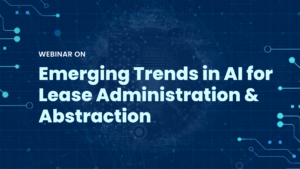Lease abstraction, once a time-consuming and labor-intensive task, has undergone a significant transformation in recent years thanks to advances in technology. In this blog post, we’ll explore the evolution of lease abstraction, from manual processes to automated solutions, and discuss the benefits of embracing technology for more efficient lease management.
The Traditional Approach: Manual Lease Abstraction
In the past, lease abstraction involved manually reviewing lease agreements, identifying key terms and obligations, and summarizing this information in a separate document. This process was time-consuming, prone to errors, and often required specialized knowledge of legal terminology.
The Challenges of Manual Lease Abstraction
- Time-Consuming Process: Reviewing lease agreements manually was a highly time-consuming task, often taking weeks or even months to complete, especially when dealing with large portfolios. Each lease agreement required careful examination, which involved reading through lengthy documents, identifying key terms and clauses, and summarizing them accurately. This process was not only labor-intensive but also prone to delays, making it challenging for businesses to keep up with their lease management requirements efficiently.
- Error-Prone: Human error was an inherent risk in the manual lease abstraction process. Despite careful review, inaccuracies in summarizing key lease terms and obligations were common. Mistakes such as misinterpretation of legal language, overlooking crucial clauses, or data entry errors could lead to significant consequences, including financial losses, compliance issues, and disputes with landlords or tenants.
- Inefficiency: As the volume of leases increased, the inefficiencies of the manual abstraction process became more pronounced. The need for meticulous review and the time-consuming nature of the task made it increasingly unsustainable. Businesses found it difficult to scale their lease management operations efficiently, leading to delays, backlogs, and a higher risk of errors. This inefficiency not only impacted productivity but also strained resources and hindered overall business performance.
The Rise of Automated Lease Abstraction
Advances in technology have transformed the lease abstraction process, making it faster, more accurate, and more efficient. Automated lease abstraction software uses artificial intelligence and machine learning algorithms to analyze lease agreements and extract key information automatically.
The Benefits of Automated Lease Abstraction
- Time-Saving: Automated lease abstraction offers a significant reduction in the time required to review lease agreements. A lease abstraction project that once took weeks or even months to complete manually can now be accomplished in a fraction of the time. With the power of automation, businesses can streamline their lease abstraction processes, allowing them to focus their time and resources on more strategic tasks. This not only increases productivity but also enables faster decision-making and improves overall operational efficiency.
- Increased Accuracy: Leveraging advanced machine learning algorithms, automated lease abstraction solutions ensure greater accuracy in extracting and summarizing key lease terms and obligations. By eliminating the potential for human error, these solutions minimize the risk of inaccuracies and discrepancies in lease data. This increased accuracy provides businesses with greater confidence in their lease information, reducing the likelihood of costly errors, disputes, and compliance issues.
- Cost-Effectiveness: Automated lease abstraction significantly reduces the need for manual labor, resulting in substantial cost savings for companies with large lease portfolios. By automating time-consuming and labor-intensive tasks, businesses can lower their operational expenses, increase efficiency, and improve their bottom line. Additionally, the reduction in errors and inaccuracies helps to mitigate potential financial risks, further contributing to cost-effectiveness and overall business success.
- Scalability: Automated lease abstraction solutions are highly scalable and can efficiently handle large volumes of leases, making them suitable for businesses of all sizes. Whether managing a small portfolio or a vast real estate empire, automated solutions can adapt to the needs of the business, ensuring seamless scalability without compromising performance or accuracy. This scalability allows businesses to grow and expand without being limited by their lease management capabilities, providing greater flexibility and agility in the marketplace.
- Simplifying the lease abstraction process: With user-friendly interfaces and intuitive features, automated lease abstraction solutions empower users to extract, organize, and analyze lease data easily.
How Automated Lease Abstraction Works
- Document Upload: The automated lease abstraction process begins with the uploading of lease agreements to the dedicated software platform. Users can easily upload lease documents in various file formats, including PDF, Word, or scanned images, providing a seamless and user-friendly experience. Once the documents are uploaded, the software initiates the data extraction process, extracting key information from the lease agreements automatically.
- Data Extraction: Leveraging advanced artificial intelligence and machine learning algorithms, the automated abstraction software analyzes the uploaded lease agreements to extract essential information. These algorithms are designed to recognize and interpret key lease terms, clauses, dates, and obligations, ensuring comprehensive data extraction with a high degree of accuracy. By automating this process, the software significantly reduces the time and effort required for manual data entry, while also minimizing the risk of errors and inaccuracies.
- Summary Generation: After extracting the necessary data from the lease agreements, the automated abstraction software generates a summarized lease abstract. This abstract provides a concise overview of the most important terms, dates, and obligations outlined in the lease agreement. The summary is structured in a clear and organized format, making it easy for users to review and understand the key details of the lease quickly. By condensing complex lease documents into simplified summaries, the software enables users to access critical information more efficiently, facilitating faster decision-making and lease management.
- Review and Verification: Once the summarized lease abstract is generated, it undergoes a thorough review and verification process to ensure accuracy and completeness. The abstract is compared against the original lease agreement to verify that all relevant information has been accurately captured. Any discrepancies or errors are identified and corrected, ensuring that the summarized abstract is a true reflection of the lease terms and obligations. This review process may involve manual intervention by legal professionals to address any complex or ambiguous language that may not have been accurately interpreted by the automated software. Once the abstract has been reviewed and verified, it is ready for use in lease management and decision-making processes.
Future Trends in Lease Abstraction
As technology continues to advance, the future of lease abstraction is poised for significant innovation. Artificial intelligence (AI) and machine learning will continue to revolutionize the process, driving efficiency and accuracy to new heights.
- AI-Powered Insights: The integration of AI-driven analytics will provide businesses with deeper insights into their lease data. By leveraging advanced algorithms, businesses will gain a comprehensive understanding of their lease portfolios, enabling them to make more informed decisions and optimize their real estate strategies for maximum efficiency and profitability. AI-powered insights will not only streamline lease management processes but also provide valuable strategic guidance for future business growth.
- Integration with Other Systems: Automated lease abstraction platforms integrate seamlessly with other key systems, such as lease accounting and property management software. This integration will create a unified ecosystem, allowing businesses to manage their entire real estate portfolio from a single platform. By breaking down data silos and facilitating seamless data exchange between systems, businesses will enhance collaboration, improve data accuracy, and streamline their overall real estate operations.
- Enhanced Security: There will be a heightened focus on data security within lease abstraction software. As businesses entrust sensitive lease information to automated platforms, there will be an increased emphasis on implementing advanced encryption and authentication measures to safeguard this data. Robust security protocols will ensure that sensitive lease information remains protected against unauthorized access, data breaches, and cyber threats. By prioritizing data security, businesses can instill confidence in their lease management processes and mitigate the risk of data breaches or compliance violations.
Automated lease abstraction represents a significant advancement in lease management technology, offering faster, more accurate, and more efficient lease abstraction solutions. By leveraging artificial intelligence and machine learning algorithms, automated lease abstraction software streamlines the process of reviewing and summarizing lease agreements, saving time and resources for property managers and real estate professionals. As technology continues to evolve, automated lease abstraction is poised to become an essential tool for businesses looking to streamline their lease management processes.

